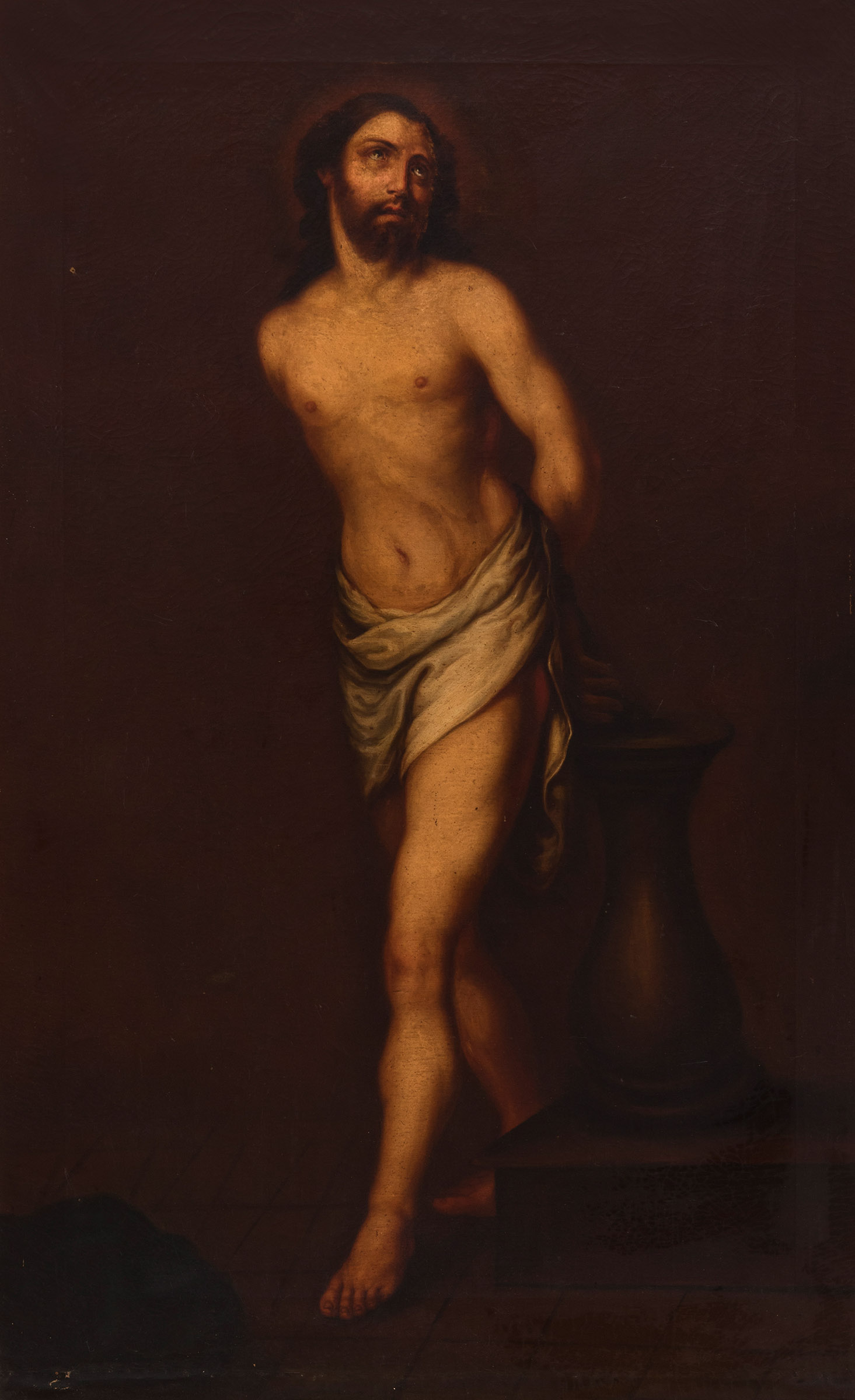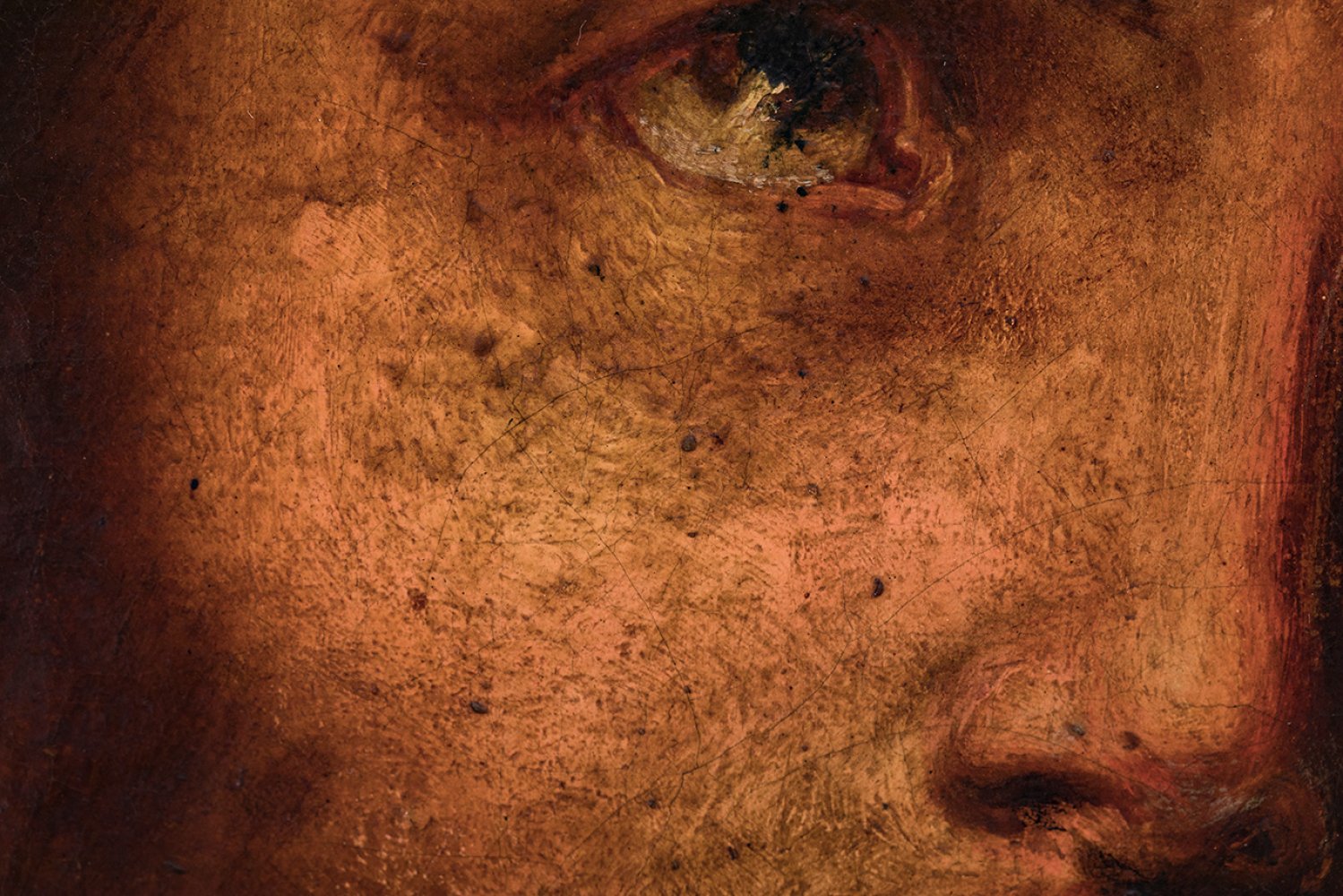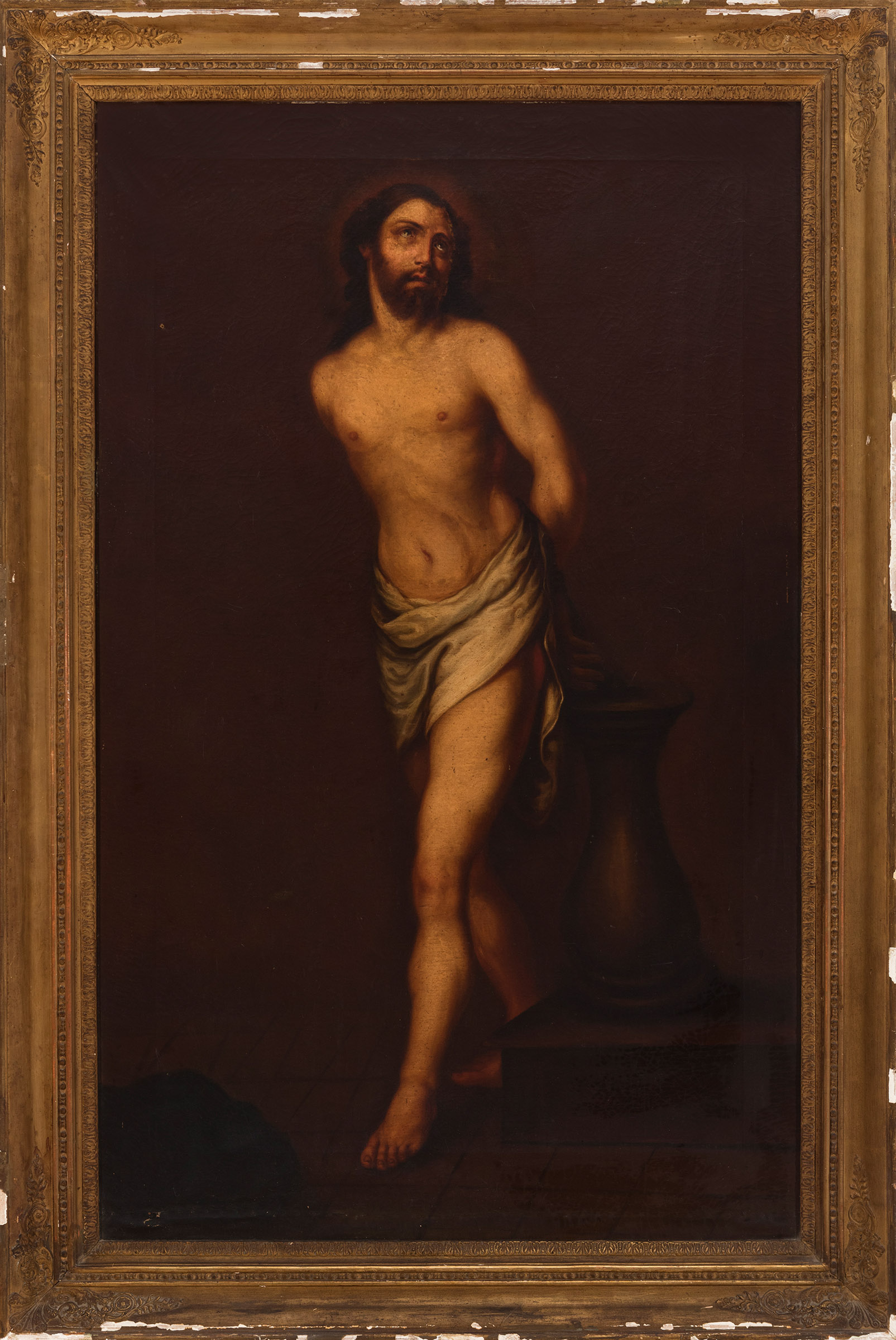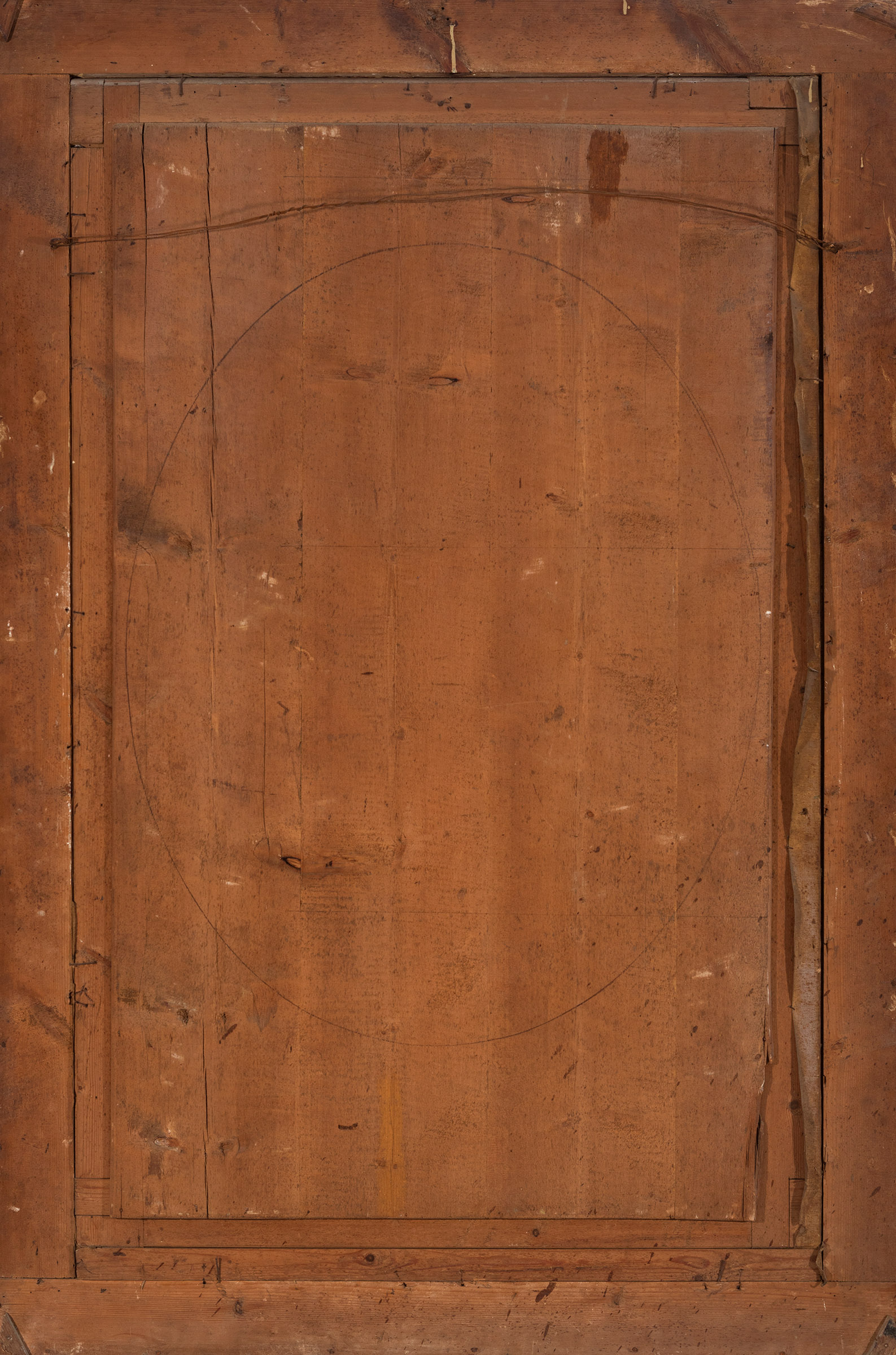44
Spanish school of the second half of the 18th century."Christ tied to the column".Oil on canvas.It
1/5
Description
Spanish school of the second half of the 18th century.
"Christ tied to the column".
Oil on canvas.
It presents faults in the frame.
Measurements: 140 x 87 cm; 161 x 108 cm (frame).
The theme of the Ecce Homo has been stripped here of all anecdote, showing Christ with his hands tied behind him to a low column, but without the narrative attributes characteristic of this episode, such as the crown of thorns and the reed in his hand that the soldiers placed on him to mock him before he was condemned. Here, the intensity of the chiaroscuro modelling the suffering body is enough to convey the pathos of the moment. The solitude of the saviour's figure, his bowed head and half-closed eyelids accentuate the character's psychological isolation in the face of complete abandonment. The cloth of purity as the only clothing absorbs the white of the contrasting lighting, rich in nuances, leaving the background dark. Only the colomna is recognisable. The anatomical work also stands out, the expressiveness of the muscles in tension, the veins and tendons that throb beneath the epidermis.
Formally, this work is related to the naturalistic Baroque trend that dominated the Spanish school in the first half of the 17th century, influenced by Caravaggio and his followers. Thus, the canvas displays all the basic characteristics of this style. Firstly, the tenebrist, artificial, focused lighting directed towards the most important areas of the composition, creating expressive chiaroscuro and leaving the rest in a nuanced semi-darkness that speaks of the painter's mastery. On the other hand, the composition is also typical of naturalism: simple, clear and realistic, with Christ in the foreground against a defined background but worked in neutral tones. Finally, we should also note the highly studied and nuanced colour range, with a palette revolving around ochres, carmines and earthy tones, typically Caravaggist.
"Christ tied to the column".
Oil on canvas.
It presents faults in the frame.
Measurements: 140 x 87 cm; 161 x 108 cm (frame).
The theme of the Ecce Homo has been stripped here of all anecdote, showing Christ with his hands tied behind him to a low column, but without the narrative attributes characteristic of this episode, such as the crown of thorns and the reed in his hand that the soldiers placed on him to mock him before he was condemned. Here, the intensity of the chiaroscuro modelling the suffering body is enough to convey the pathos of the moment. The solitude of the saviour's figure, his bowed head and half-closed eyelids accentuate the character's psychological isolation in the face of complete abandonment. The cloth of purity as the only clothing absorbs the white of the contrasting lighting, rich in nuances, leaving the background dark. Only the colomna is recognisable. The anatomical work also stands out, the expressiveness of the muscles in tension, the veins and tendons that throb beneath the epidermis.
Formally, this work is related to the naturalistic Baroque trend that dominated the Spanish school in the first half of the 17th century, influenced by Caravaggio and his followers. Thus, the canvas displays all the basic characteristics of this style. Firstly, the tenebrist, artificial, focused lighting directed towards the most important areas of the composition, creating expressive chiaroscuro and leaving the rest in a nuanced semi-darkness that speaks of the painter's mastery. On the other hand, the composition is also typical of naturalism: simple, clear and realistic, with Christ in the foreground against a defined background but worked in neutral tones. Finally, we should also note the highly studied and nuanced colour range, with a palette revolving around ochres, carmines and earthy tones, typically Caravaggist.
Auction Details
Shipping
T&Cs & Important Info
Ask seller a question
Spanish school of the second half of the 18th century.
"Christ tied to the column".
Oil on canvas.
It presents faults in the frame.
Measurements: 140 x 87 cm; 161 x 108 cm (frame).
The theme of the Ecce Homo has been stripped here of all anecdote, showing Christ with his hands tied behind him to a low column, but without the narrative attributes characteristic of this episode, such as the crown of thorns and the reed in his hand that the soldiers placed on him to mock him before he was condemned. Here, the intensity of the chiaroscuro modelling the suffering body is enough to convey the pathos of the moment. The solitude of the saviour's figure, his bowed head and half-closed eyelids accentuate the character's psychological isolation in the face of complete abandonment. The cloth of purity as the only clothing absorbs the white of the contrasting lighting, rich in nuances, leaving the background dark. Only the colomna is recognisable. The anatomical work also stands out, the expressiveness of the muscles in tension, the veins and tendons that throb beneath the epidermis.
Formally, this work is related to the naturalistic Baroque trend that dominated the Spanish school in the first half of the 17th century, influenced by Caravaggio and his followers. Thus, the canvas displays all the basic characteristics of this style. Firstly, the tenebrist, artificial, focused lighting directed towards the most important areas of the composition, creating expressive chiaroscuro and leaving the rest in a nuanced semi-darkness that speaks of the painter's mastery. On the other hand, the composition is also typical of naturalism: simple, clear and realistic, with Christ in the foreground against a defined background but worked in neutral tones. Finally, we should also note the highly studied and nuanced colour range, with a palette revolving around ochres, carmines and earthy tones, typically Caravaggist.
"Christ tied to the column".
Oil on canvas.
It presents faults in the frame.
Measurements: 140 x 87 cm; 161 x 108 cm (frame).
The theme of the Ecce Homo has been stripped here of all anecdote, showing Christ with his hands tied behind him to a low column, but without the narrative attributes characteristic of this episode, such as the crown of thorns and the reed in his hand that the soldiers placed on him to mock him before he was condemned. Here, the intensity of the chiaroscuro modelling the suffering body is enough to convey the pathos of the moment. The solitude of the saviour's figure, his bowed head and half-closed eyelids accentuate the character's psychological isolation in the face of complete abandonment. The cloth of purity as the only clothing absorbs the white of the contrasting lighting, rich in nuances, leaving the background dark. Only the colomna is recognisable. The anatomical work also stands out, the expressiveness of the muscles in tension, the veins and tendons that throb beneath the epidermis.
Formally, this work is related to the naturalistic Baroque trend that dominated the Spanish school in the first half of the 17th century, influenced by Caravaggio and his followers. Thus, the canvas displays all the basic characteristics of this style. Firstly, the tenebrist, artificial, focused lighting directed towards the most important areas of the composition, creating expressive chiaroscuro and leaving the rest in a nuanced semi-darkness that speaks of the painter's mastery. On the other hand, the composition is also typical of naturalism: simple, clear and realistic, with Christ in the foreground against a defined background but worked in neutral tones. Finally, we should also note the highly studied and nuanced colour range, with a palette revolving around ochres, carmines and earthy tones, typically Caravaggist.
29th December - Old Masters
Sale Date(s)
Venue Address
Aragón 346, Barcelona
Calle Velázquez 7, Madrid
Carrer de Cirilo Amorós 55, Valencia
Barcelona
08009
Spain
General delivery information available from the auctioneer
Setdart offers Worldwide shipping
PICK UP IN ROOM: You can come and pick up your lots in our offices (Barcelona, Madrid or Valencia). At the moment of the withdrawal, you will be able to accept the current conditions of the lot by means of a document that you will sign.
YOU CAN SEND ANOTHER PERSON TO PICK UP: This person must present a signed authorization that you can find in our web page by accessing from BUY AT SETDART- LOGISTICS-DOWNLOAD AUTHORIZATION DOCUMENT. You can also send an e-mail with the requested data in AUTHORIZATION DOCUMENT to admin@setdart.com
Important Information
25% buyer´s premium
21% buyer´s premium at www.setdart.com















